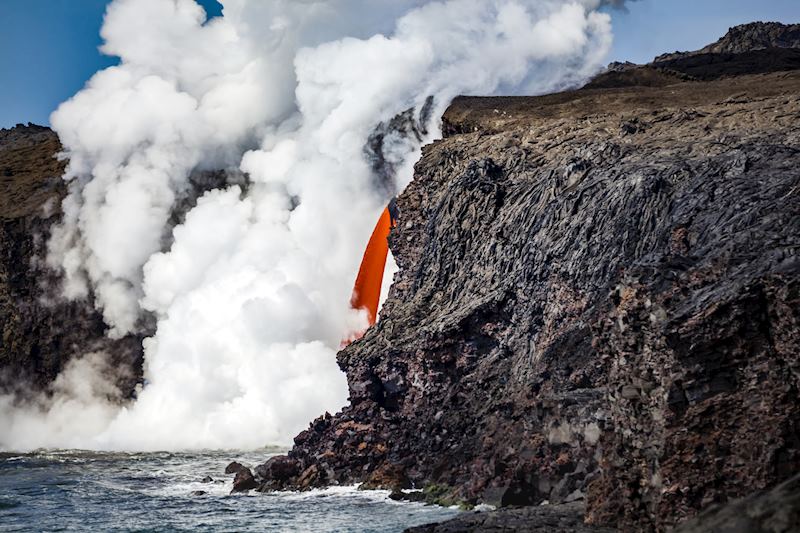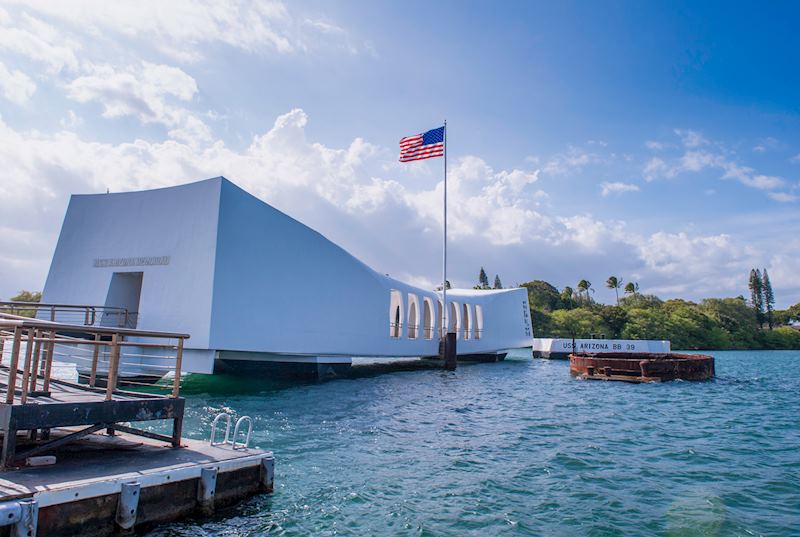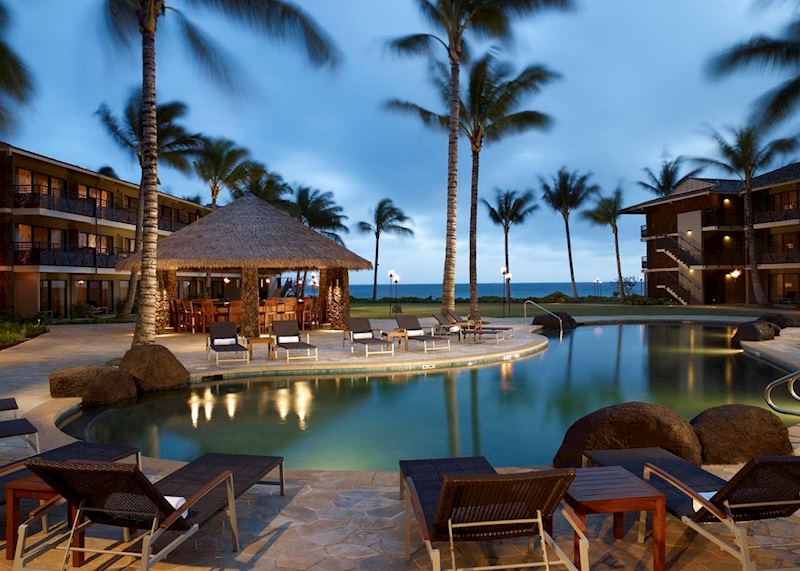By Audley specialist Gillian
Hawaii is often perceived as a tropical island paradise, where white sands merge with clear water and days are given up to relaxing beneath palm trees. While this is true to some extent, it’s by no means the whole story. Forested hiking trails lead to hidden waterfalls, while scenic drives and helicopter rides take in coastlines that have turned the heads of Hollywood filmmakers.
Formed by volcanic activity millions of years ago, the islands continue to be shaped by the ever-apparent forces of nature. You can observe molten lava bubbling and glowing in HawaiŹ»i Volcanoes National Park and snorkel among tropical fish in the submerged Molokini volcanic crater.
How many islands can you cover in a trip?

Part of the joy of visiting Hawaii is that you can pick and choose from its six main islands: °æŹ»²¹³ó³Ü, °²¹³Ü²¹Ź»¾±, Maui, the island of HawaiŹ»i and the two smaller islands of ²Ń“Ē±ō“Ē°ģ²¹Ź»¾± and ³¢Äå²Ō²¹Ź»¾±. Each offers something different, from adventurous outdoor activities and the trademark sandy beaches, to volcanic formations, winding coastal drives, and traditional Hawaiian culture.
°æŹ»²¹³ó³Ü, °²¹³Ü²¹Ź»¾±, Maui and the island of HawaiŹ»i have direct flights to and from mainland USA: around a six-hour journey from the USA’s west coast.
It’s easy to visit multiple islands in one trip; I’d say two weeks gives enough time to cover three or four. Connecting flights typically last around half an hour, without the need for long airport waits.
As there’s limited public transport on the islands, self-driving is the most practical means of getting around. Roads are well maintained and easy to navigate.
Things to see and do in Hawaii
°æŹ»²¹³ó³Ü
More American in feel than the other islands and home to Hawaii’s capital, Honolulu, °æŹ»²¹³ó³Ü is by far the most populated island.
I recommend staying for a couple of nights, making time to visit Hawaii’s best-known beach, WaikÄ«kÄ«, with its golden sand and surfer atmosphere, as well as Pearl Harbor.
Visiting Pearl Harbor


I couldn’t pass through °æŹ»²¹³ó³Ü without visiting the place where the USA’s involvement in World War II first began, Pearl Harbor. It was a moving experience visiting the site and seeing the names of more than 2,400 people who lost their lives engraved on the memorial plaque.
While three of the sunken battleships were raised and returned to service, the USS Arizona still resides in its watery grave. Its memorial is built over the wreckage, so you can look down and see the submerged ship.
Throughout the site are exhibits, displays and memorials related to the events leading up to the fateful day, what happened during the attack, and the people affected on both sides.
Where to stay on °æŹ»²¹³ó³Ü
The Halekulani Hotel is set on WaikÄ«kÄ« Beach, and every room and suite has a private lanai (balcony). As a guest, you gain free access to some of °æŹ»²¹³ó³Ü’s art and cultural venues.
The island of HawaiŹ»i

An island of two halves, the eastern side of the island of HawaiŹ»i is dominated by HawaiŹ»i Volcanoes National Park, home to some of the world’s most active volcanoes — including KÄ«lauea. The west, meanwhile, has a coastline made up of long stretches of pale-gold sand lapped by clear turquoise waters.
I personally liked HÄpuna Beach best, whose wide, soft sands are a designated state recreation area. Farther south is Kealakekua Bay, where Captain Cook was killed by islanders in 1779 — a large white monument marks the spot.
Inland, dense jungle hides misty waterfalls, and Hawaii’s highest peak, Mauna Kea, dominates the skyline.
There are airports at eastern Hilo and Kona in the west, so you can spend time on both sides of the island.
HawaiŹ»i Volcanoes National Park

The island of HawaiŹ»i is the largest in the archipelago, as well as the most recently formed, and HawaiŹ»i Volcanoes National Park is the best place in Hawaii to see the forces at work beneath the Earthās crust. Here you can take in dark, sprawling lava fields strewn with boulders, steaming craters and cinder cones, and occasionally aglow with bubbling molten lava.
While a helicopter ride gives you a wide-angle perspective over the park and KÄ«lauea, itās easy to explore the landscape independently by car and on foot. The KÄ«lauea Visitor Center has information on suggested hiking trails and drives that take in the drama of this dynamic landscape.
Exploring on foot, I passed huge chunks of charred debris and cracks in the ground filled with red molten lava. I walked across the charcoal-hued swirls of once-oozing lava, seeing where it had suddenly cooled, mid-flow, forming thick layers of stone. Sunken road signs are an eerie reminder of the lavaās destructive force.
The park also contains the Puāuloa archaeological site, where more than 23,000 petroglyphs were etched into the rock hundreds of years ago by native Hawaiians. You can follow a boardwalk to view some of the carvings, which include geometric patterns and images of people, canoes and animals.
Stargazing from Mauna Kea

The occasionally snow-covered dome of Mauna Kea sits between the two contrasting sides of the island of HawaiŹ»i. Its height at 4,207 m (13,802 ft) and remoteness make it one of the best places on Earth for studying the night sky. Nightly tours will take you to the dormant volcano’s summit to view the heavens at the site where astronomers discovered several of Jupiter’s moons.
After an alfresco dinner, you’re driven for 45 minutes up the winding road to Mauna Kea’s peak. The air is much thinner here, so only those aged 16 and over are permitted. On my visit, the sea of clouds below us was tinged pink and violet as the sun sank. Above, orange, red and yellow streaks burst across the sky before it darkened and the first stars began to show.
We were then taken down to the Visitor Information Station, where public telescopes are set up each night. Our guide pointed out constellations and planets — I even made out the rings of Saturn.
Night-time snorkel with manta rays

Just off Konaās coast, as evening falls, plankton rises toward the oceanās surface, which in turn attracts manta rays. Departing at dusk by boat with a guide, as part of a small group, you have the chance to see these elegant creatures (which can reach between 5 and 7 m [18 and 23 ft] in diameter) up close in their natural habitat.
After donning your snorkel gear, you enter the water and hold onto a raft fitted with specially designed diving lights that attract the plankton. As soon as my face was submerged I was astounded by how many manta rays were swimming just below me. It felt like I was watching a ballet as I observed their gentle, graceful movements as they fed, oblivious to my proximity.
Where to stay on the island of HawaiŹ»i
In the west, the Four Seasons Resort Hualalai has an oceanfront setting on a stretch of golden sand.

Maui
Dubbed the āValley Isleā, Maui was the closest match to the Hawaii of my imagination: soft sands (both classic white and volcanic black), rainforests running with streams and waterfalls, and elevated points gazing down on sweeping views over the Pacific. Itās a honeymoonerās haunt, but in truth it would suit anyone who likes to combine beaches, wildlife and tropical island scenery.
The Road to HÄna

My last trip to Hawaii didnāt get better than winding along Mauiās northern coastline on the Road to HÄna. Stretching for 103 km (64 miles) between Kahului and HÄna, this scenic drive is more about the journey than the destination.
What would take a couple of hours without any breaks turns into a full dayās outing as the ocean views urge you to stop at every opportunity to take photographs, and mile markers pinpoint places of interest that tug at your adventurous side.
Trails lead to waterfalls and lagoons where you can take a dip, while PaŹ»iloa Beachās black sand makes a novel change to the usual white or gold stretches. Shacks dotted along the road sell banana bread, coconuts and pineapples.
The drive climaxed when I stopped at Hoāokipa Beach, just outside HÄna, at sunset. At this time throughout the year, groups of green sea turtles often come ashore for the night. I watched as around ten of them appeared from the waves and settled into the sand just a few steps away. A volunteer was on hand to answer questions and keep a buffer around these protected creatures.
Snorkelling in the Molokini Crater

A vivid-green crescent rising from the sea just off Mauiās southwest coast, the Molokini Crater was formed some 200,000 years ago by a volcanic eruption. The coral reef inside the crater now supports an array of marine life and is a designated Marine Life Conservation District.
You can join a sailing trip out to Molokini to snorkel among the coral reef. Beneath the waves you might glimpse fish such as Picasso and reef triggerfish, the white-spotted puffer, yellow trumpet fish and parrotfish, as well as manta rays, moray eels, ornate (or white-striped) octopuses and reef sharks.
If youāre visiting between December and February, you can also look out for humpback whales, when they migrate to Hawaii from the Pacific Northwest to breed. You might also spot spinner dolphins and can listen to their calls using hydrophones.
Where to stay on Maui
Mamaās Fish House Restaurant & Inn is one of Hawaiiās only boutique properties, with just 13 beachfront and garden cottages. I particularly recommend it if youāre driving the Road to HÄna, as itās near the start of the drive (or the end, if you do the return journey). Its restaurant ā Iād say one of the best on the island ā serves freshly caught seafood.


°²¹³Ü²¹Ź»¾±
Sharp, folded peaks rise vertically from the ocean, the grey rock almost entirely covered in vegetation. With much of °²¹³Ü²¹Ź»¾±ās steep-sided coastline only accessible by boat, helicopter or on foot, it feels wilder and remoter than the other islands. But the landscape hasnāt been overlooked by Hollywood: films such as Jurassic Park, South Pacific and Raiders of the Lost Ark used the island as a backdrop.
Helicopter trip over the island

I found that to really get to know °²¹³Ü²¹Ź»¾±, which has just one main road, you need to think about other methods of transport. A helicopter ride reveals the islandās volcanically shaped landscape of velvety green serrated peaks and tangled forest in its entirety.
In just an hour you drift over the heavily forested Hanapepe Valley, the splaying white waters of Manawaiopuna Falls (known as Jurassic Falls due to its appearance in the Hollywood blockbuster), and the Waimea Canyon. You also fly over the NÄ Pali Coast, a stretch of steep, notched sea cliffs, deep-cut valleys and hidden sandy coves thatās so beautiful itās sacred to Hawaiians.
Depending on the weather, you might also get the chance to fly into the heart of Mount WaiŹ»aleŹ»ale, an extinct volcano reputed to be the wettest spot on Earth. As you descend into its crater, youāre surrounded by huge sheer-sided walls covered in vegetation and streaming with thin, wispy waterfalls.
Hiking around °²¹³Ü²¹Ź»¾±

Iād argue that °²¹³Ü²¹Ź»¾± is the best island for getting out and exploring on foot. Its dense forests feel undiscovered and are punctuated with waterfalls, caves and natural pools. Coastal trails give you access to dizzying cliffs and undisturbed beaches.
One of the more strenuous routes is the Kalalau Trail, an 18 km (11 mile) walk that winds along the NÄ Pali Coast and into the Kalalau Valley, whose sides rise upward of 600 m (2,000 ft). The trail ends at the secluded Kalalau Beach at the base of the valley, where you can rest on the golden sand.
A gentler option is to stroll in KÅkeŹ»e State Park or follow the 2.4 km (1.5 mile) trail from the Kuilau trailhead. This takes you into the forest and eventually to views over the mountains and valleys below.
Where to stay on °²¹³Ü²¹Ź»¾±
Koa Kea Hotel and Resort is one of the islandās smaller properties, and its low-rise buildings are more sympathetic to the surroundings. Itās set a few paces from a sandy beach, and you can rent equipment for snorkelling and surfing.


Cultural experiences in Hawaii
Whichever Hawaiian island youāre on, even the increasingly Westernised larger islands, youāll get the sense that people here are still fiercely proud of their Ź»ohana (family heritage). Cultural practices continue to be passed down the generations.
Most large hotels hold regular luaus in the evening ā traditional feasts accompanied by dance and song. They arenāt the most authentic experience, but they do open your eyes to the archipelagoās Polynesian influences. Youāre given a lei (garland), and a whole pig is brought out and spit roasted. As you eat, performers tell stories through their indigenous songs and traditional dancing, creating a light-hearted atmosphere.
²Ń“Ē±ō“Ē°ģ²¹Ź»¾± and ³¢Äå²Ō²¹Ź»¾±

Seeing far fewer visitors, the smaller islands of ²Ń“Ē±ō“Ē°ģ²¹Ź»¾± and ³¢Äå²Ō²¹Ź»¾± have unspoiled natural beauty and villages where a traditional rural lifestyle prevails. On ²Ń“Ē±ō“Ē°ģ²¹Ź»¾±, the larger of the two, cultural events are held throughout the year, such as a celebration of hula dancing, which originated here, and outrigger canoe races. I also suggest visiting Kalaupapa National Historical Park, whose green hills sloping to wide and untouched sandy beaches belie its dark history as a former leprosy settlement.
On ³¢Äå²Ō²¹Ź»¾±, you can explore KaunolÅ« Fishing Village, the largest surviving ruins of a prehistoric Hawaiian village. You can also see Puāupehe (Sweetheart Rock) just offshore between Manele and HulopoŹ»e Bay. Legend says that this sea stack was where a young warrior, Makakehau, buried his Hawaiian maiden before jumping into the waves.
Start planning your Hawaii trip
Start thinking about your experience. These itineraries are simply suggestions for how you could enjoy some of the same experiences as our specialists. They're just for inspiration, because your trip will be created around your particular tastes.
View All Tours in Hawaii



